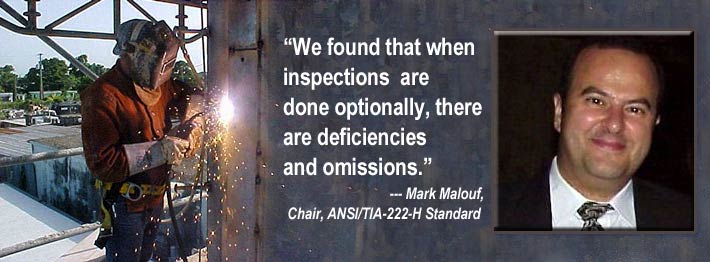
The new ANSI/TIA‐222-H Standard, the “Structural Standard for Antenna Supporting Structures and Antennas and Small Wind Turbine Structures,” the latest revision of the TIA-222 Standard that builds on the changes introduced in the Revision G and enhances and expands them, is expected to be published in the third quarter of 2017. Revision H has loading and design strength provisions revised to be in conformance with changes in the referenced source national standards. Several new annexes are added to address industry practice and requirements.
According to Mark Malouf, chair of Task Group 3, which developed ANSI/TIA-222-H, and vice chair of the TR-14 engineering committee, two new annexes have been added to the standard identifying a required initial construction inspection and an inspection after modifications are made on an existing structure.
The initial inspection includes a foundation and grounding inspection requiring concrete mix design documentation, concrete tests, anchorage compliance, grounding material placement, backfill material and placement documentation and other verification requirements.
It also requires a maintenance and condition assessment within 120 days of installation as well as the need to perform bolt pre-tensioning testing and installation of nut-locking and leveling nuts tightened in accordance with the standard. Jacking and lap lengths for tubular pole structures’ splices will also be required in addition to the necessity of ensuring climbing facilities, including safety climb systems, are unobstructed. There are installation tolerance checks and a number of other inspection requirements.
The guidelines for inspection of modifications to existing steel structures before, during and after the construction phase are also provided and include fabricator certified weld inspections, a material test report, weld documentation for field welding and multiple other requirements.
Malouf said, “We found that when inspections are done optionally, there are deficiencies and omissions.”
Although major tower owners require these inspections and add additional requirements, a number of structures built or modified by smaller tower owners do not require adequate inspections.
Depending upon the scope of work, an inspection could cost between $2,000 and $3,000, according to industry estimators.
The new revision also addresses U-bolts. Malouf said that that they have not been addressed previously and Revision H calculates the capacity of round and square U-bolts.
“A lot of research went into U-bolts,” Malouf said.
Malouf is President of Malouf Engineering, a consulting engineering firm specializing in design, analysis and modification of telecommunication structures.
The changes in the upcoming ANSI/TIA‐222-H Standard are summarized as follows:
Incorporates ASCE 7-16 Standard revised Wind maps with ultimate wind speeds based on risk category and the Wind and Ice Maps.
Update the load factors to account for the ultimate wind speeds and adds a ground elevation factor.
Enhances Section 2 (Loads) provisions including Exposure Categories based on surface roughness, more defined Risk Categories, expands Topographic effects approach using 3 methods and adds rooftop wind speed-up factor.
Update and enhances the Seismic section 2.7 to be in conformance with ASCE 7-16 and ACI 318-14 standards and eliminates the exception for seismic loading analysis in low seismic regions.
Update Section 4 (Design Strength) requirements for changes in the Steel and Concrete Standards, AISC 360-16 & ACI 318-14, revises the Anchor Rods section and adds a new section to address U-bolts design strength.
Update Section 9 (Foundation and Anchorages) for changes to ACI 318-14 and enhances several provisions including direct embed foundations.
Update Section 10 (Protective Grounding) provisions.
Update Section 12 (Climbing Facilities) to be in sync with other safety standards including ASSE A10.48.
Update Section 15 (Existing Structures), defines comprehensive structural analysis and feasibility study and adds the existing structures load modification factors.
Addition of new Section 16 for Mounting Systems to address their criteria.
Incorporates and enhances the Tubular Pole Base Plate from Revision G Addendum 3 as a new Annex Q and the Small Wind Turbine Structures from Revision G addendum 4 as a new Section 17.
Addition of new annexes for Wind Induced Structural Oscillations (Annex M), New Tower Construction (Annex N), Existing Tower Modification Inspection (Annex O) and Tubular Pole Weld Toe Crack Evaluation (Annex P).
Updates to the other sections and annexes to reflect changes in the main sections of standard.

















